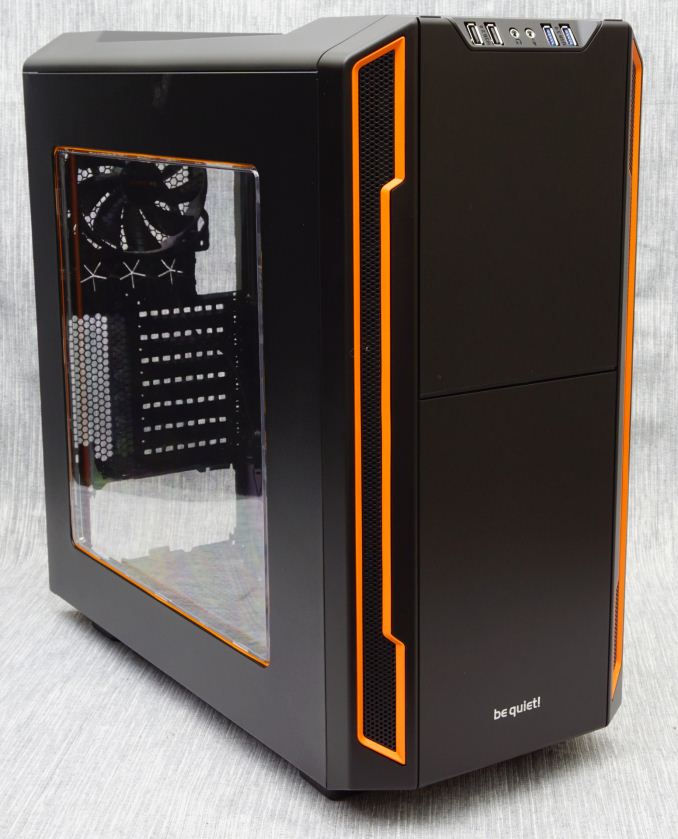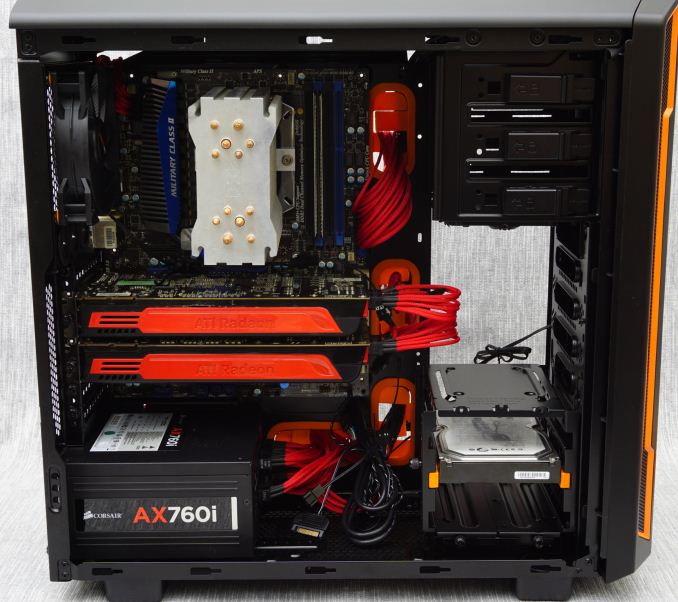The Be Quiet! Silent Base 600 ATX Case Review
by E. Fylladitakis on November 17, 2016 9:00 AM EST- Posted in
- Cases/Cooling/PSUs
- be quiet!
- ATX
- Case
- Silent Base 600
Conclusion
Be Quiet! designed the Silent Base 600 to be a high quality, cost-effective case focused on low-noise operation. In terms of quality, the materials used are very good and the overall build is durable enough for a typical ATX tower case. The core chassis however seems to be more of a retrofitted old design rather than a modern case, with low clearances and few usability features. Modern gaming systems, especially those designed with low-noise operation in mind, often make use of liquid cooling solutions in order to achieve acceptable thermal performance levels. The Silent Base 600 is incompatible with a very large percentage of the currently available all-in-one coolers, as well as being incompatible with very tall air coolers. The designer did install holes for the use of large external liquid coolers, but such a cooler defeats the core purpose of the Silent Base 600 by transferring a major noise source outside of the case.
Even though the core design of the chassis seems is what it is, the design does deliver excellent noise insulation as promised. The Silent Base 600 has excellent sound-dampening capabilities and the stock cooling fans are barely audible even at their maximum speed. With its stock cooling fans down at their minimum speed and a quality low-noise CPU cooler, the Silent Base 600 should be more than capable of providing seamless and completely silent operation with a medium-power CPU and GPU installed. For advanced gaming systems, especially multi-GPU systems or systems with significantly overclocked components, the cooling system of the Silent Base 600 should definitely be upgraded. The installation of more fans or loud components in the Silent Base 600 will certainly make the overall system audible, yet the acoustic insulation of the case will in any case dampen that noise, resulting to comparatively better acoustic performance. In extreme circumstances, where the inability of installing large coolers/radiators becomes an important factor and forces the user to compensate with additional airflow, the noise output of the Silent Base 600 can match or even exceed that of more spacious cases with greatly superior thermal performance.
In summary, we discovered that the Be Quiet! Silent Base 600 practically is a remodeled older chassis that is heavily balanced towards low-noise operation. The thermal performance of the Silent Base 600 leaves much to be desired, but the acoustic performance is truly exceptional. However, in North America Be Quiet! is fighting an uphill battle against the competition when it comes to value. The Silent Base 600 is the first case that we have seen to this date that is more expensive in the US rather than in the EU, and it already is expensive in the EU. With a retail price of $127 at the time of this review, the Silent Base 600 is going to face very steep competition, as much more advanced cases are available near this price point.












24 Comments
View All Comments
Pariah - Monday, November 21, 2016 - link
That's the most recent video card they have done a full review of. No time for video card reviews when a new ssd or cell phone no one cares about is released every week.arizzek - Monday, November 21, 2016 - link
I think in this coumputer is only Radeon HD 5770http://american-truck-crack.website/
Thrawn - Thursday, November 17, 2016 - link
Looks like a nice case in a few ways especially of course for those that demand quiet.Is there some reason I am not aware of that none of the high end cases that get reviewed ever seem to have the new USB-C ports? Not really a complaint about this case specifically so much as of the industry in general. I figure if I get a case I want to use it for a very long time since it doesn't exactly die of old age like a lot of components so I want it to support new connection standards at least a little.
DanNeely - Thursday, November 17, 2016 - link
Chicken and egg lag. Made worse by the same phenomena meaning that most cases only have 2 USB3 front panel ports and the mobos only have a single 3.0 header. And unfortunately, until the USB audio people sort out their problems with USB3 people with headsets are going to maintain a demand for 2.0 ports on the front.eek2121 - Thursday, November 17, 2016 - link
It's not just audio, some memory card readers have issues as well. I also own a keyboard that doesn't work.Timur Born - Sunday, November 20, 2016 - link
USB audio issues are mostly happening with non Intel based USB 3.0 ports (Asmedia), though, plus flaky cabling for those front case ports.rocky12345 - Thursday, November 17, 2016 - link
Very nice looking case for sure. Yes the flat front look has grown on me and I like it that they have tried to keep everyone happy by including 5.25 bays and 3.5 drive cages in a world that hates them. I would for sure tell a friend to get one if they wanted something quiet and look fairly good as well. Oh was nice to see they did not in close the power supply area as well.ThaneDE - Thursday, November 17, 2016 - link
"They currently have two different cases, the Silent Base 600 and the Silent Base 800"That statement is not true anymore - BeQuiet has recently released their 3rd case, the Dark Base 900, a very modable full-tower. See here: http://www.bequiet.com/de/case/699
mobutu - Friday, November 18, 2016 - link
"Noise testing has been performed with a background noise level of 30.4dB(A)."I wonder how you'll test those cases that are (default or undervolted) below your background noise.
And there are.
So far it seems that you only had just turbine cases as samples ;)
E.Fyll - Monday, November 21, 2016 - link
That is actually a misconception. You cannot have anything producing noise "below" your background noise. Sound energy is cumulative, meaning that every additional noise source is being logarithmically added to the whole. If something is producing even 0.1 dB(A), this will be logarithmically added to the base background noise of the room.That is how laboratory testing works. The instrumentation reads the base sound energy within the chamber, the sound energy that the tested sample produces, and then mathematically calculates the sound pressure of the tested sample assuming a baseline sound pressure of 0 dB(A). Although laboratories do have mechanically isolated rooms for such testing, the sound pressure in the chamber is never truly 0 dB; it is the equipment that has been tuned to take 0 dB as the calculation reference. You cannot truly have 0 dB anywhere in nature except in the void of space.